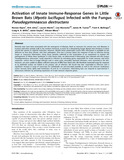Activation of Innate Immune-Response Genes in Little Brown Bats (Myotis lucifugus) Infected with the Fungus Pseudogymnoascus destructans
Metadata
Show full item recordAuthor
Rapin, Noreen
Johns, Kirk
Martin, Lauren
Warnecke, Lisa
Turner, James M.
Bollinger, Trent K.
Willis, Craig K. R.
Voyles, Jamie
Misra, Vikram
Date
2014-11-12Citation
Rapin, N., K. Johns, L. Martin, L. Warnecke, J. M. Turner, et al. "Activation of Innate Immune-Response Genes in Little Brown Bats (Myotis lucifugus) Infected with the Fungus Pseudogymnoascus destructans." PLoS ONE 9(11) (2014): e112285. DOI: 10.1371/journal.pone.0112285.
Abstract
Recently bats have been associated with the emergence of diseases, both as reservoirs for several new viral diseases in humans and other animals and, in the northern Americas, as hosts for a devastating fungal disease that threatens to drive several bat species to regional extinction. However, despite these catastrophic events little Information is available on bat
defences or how they interact with their pathogens. Even less is known about the response of bats to infection during torpor or long-term hibernation. Using tissue samples collected at the termination of an experiment to explore the pathogenesis of White Nose Syndrome in Little Brown Bats, we determined if hibernating bats infected with the fungus Pseudogymnoascus destructans could respond to infection by activating genes responsible for innate immune and stress responses. Lesions due to fungal infection and, in some cases, secondary bacterial infections, were restricted to the skin. However, we were unable to obtain sufficient amounts of RNA from these sites. We therefore examined lungs for response at an epithelial surface not linked to the primary site of infection. We found that bats responded to infection with a significant increase in lungs of transcripts for Cathelicidin (an anti-microbial peptide) as well as the immune modulators tumor necrosis factor alpha and interleukins 10 and 23. In conclusion, hibernating bats can respond to experimental P.
destructans infection by activating expression of innate immune response genes.

